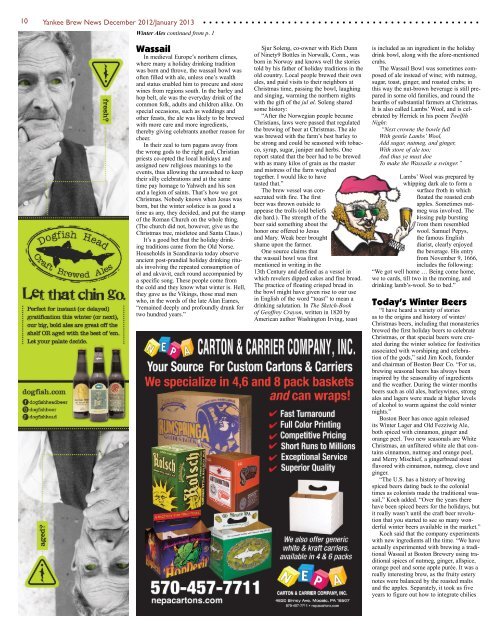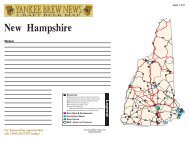Create successful ePaper yourself
Turn your PDF publications into a flip-book with our unique Google optimized e-Paper software.
10 Yankee Brew <strong>News</strong> December 2012/January 2013<br />
Winter Ales continued from p. 1<br />
Wassail<br />
In medieval Europe’s northern climes,<br />
where many a holiday drinking tradition<br />
was born and throve, the wassail bowl was<br />
often filled with ale, unless one’s wealth<br />
and status enabled him to procure and store<br />
wines from regions south. In the barley and<br />
hop belt, ale was the everyday drink of the<br />
common folk, adults and children alike. On<br />
special occasions, such as weddings and<br />
other feasts, the ale was likely to be brewed<br />
with more care and more ingredients,<br />
thereby giving celebrants another reason for<br />
cheer.<br />
In their zeal to turn pagans away from<br />
the wrong gods to the right god, Christian<br />
priests co-opted the local holidays and<br />
assigned new religious meanings to the<br />
events, thus allowing the unwashed to keep<br />
their silly celebrations and at the same<br />
time pay homage to Yahweh and his son<br />
and a legion of saints. That’s how we got<br />
Christmas. Nobody knows when Jesus was<br />
born, but the winter solstice is as good a<br />
time as any, they decided, and put the stamp<br />
of the Roman Church on the whole thing.<br />
(The church did not, however, give us the<br />
Christmas tree, mistletoe and Santa Claus.)<br />
It’s a good bet that the holiday drinking<br />
traditions came from the Old Norse.<br />
Households in Scandinavia today observe<br />
ancient post-prandial holiday drinking rituals<br />
involving the repeated consumption of<br />
øl and akvavit, each round accompanied by<br />
a specific song. These people come from<br />
the cold and they know what winter is. Hell,<br />
they gave us the Vikings, those mad men<br />
who, in the words of the late Alan Eames,<br />
“remained deeply and profoundly drunk for<br />
two hundred years.”<br />
Sjur Soleng, co-owner with Rich Dunn<br />
of Ninety9 Bottles in Norwalk, Conn., was<br />
born in Norway and knows well the stories<br />
told by his father of holiday traditions in the<br />
old country. Local people brewed their own<br />
ales, and paid visits to their neighbors at<br />
Christmas time, passing the bowl, laughing<br />
and singing, warming the northern nights<br />
with the gift of the jul øl. Soleng shared<br />
some history:<br />
“After the Norwegian people became<br />
Christians, laws were passed that regulated<br />
the brewing of beer at Christmas. The ale<br />
was brewed with the farm’s best barley to<br />
be strong and could be seasoned with tobacco,<br />
syrup, sugar, juniper and herbs. One<br />
report stated that the beer had to be brewed<br />
with as many kilos of grain as the master<br />
and mistress of the farm weighed<br />
together. I would like to have<br />
tasted that.”<br />
The brew vessel was consecrated<br />
with fire. The first<br />
beer was thrown outside to<br />
appease the trolls (old beliefs<br />
die hard.). The strength of the e<br />
beer said something about the e<br />
honor one offered to Jesus<br />
and Mary. Weak beer brought t<br />
shame upon the farmer.<br />
One source claims that<br />
the wassail bowl was first<br />
mentioned in writing in the<br />
13th Century and defined as a vessel in<br />
which revelers dipped cakes and fine bread.<br />
The practice of floating crisped bread in<br />
the bowl might have given rise to our use<br />
in English of the word “toast” to mean a<br />
drinking salutation. In The Sketch-Book<br />
of Geoffrey Crayon, written in 1820 by<br />
American author Washington Irving, toast<br />
is included as an ingredient in the holiday<br />
drink bowl, along with the afore-mentioned<br />
crabs.<br />
The Wassail Bowl was sometimes composed<br />
of ale instead of wine; with nutmeg,<br />
sugar, toast, ginger, and roasted crabs; in<br />
this way the nut-brown beverage is still prepared<br />
in some old families, and round the<br />
hearths of substantial farmers at Christmas.<br />
It is also called Lambs’ Wool, and is celebrated<br />
by Herrick in his poem Twelfth<br />
Night:<br />
“Next crowne the bowle full<br />
With gentle Lambs’ Wool,<br />
Add sugar, nutmeg, and ginger,<br />
With store of ale too;<br />
And thus ye must doe<br />
To make the Wassaile a swinger.”<br />
Lambs’ L Wool was prepared by<br />
whipping whippin w pp dark ale to form a<br />
surface su froth in which<br />
floated fl the roasted crab<br />
apples. ap Sometimes nutmeg<br />
m was involved. The<br />
hissing hi h pulp bursting<br />
from fr them resembled<br />
wool. w Samuel Pepys,<br />
the th famous English<br />
diarist, di clearly enjoyed<br />
the th beverage. His entry<br />
from fr November 9, 1666,<br />
includes the following:<br />
“We got well home … Being come home,<br />
we to cards, till two in the morning, and<br />
drinking lamb’s-wool. So to bed.”<br />
Today’s Winter Beers<br />
“I have heard a variety of stories<br />
as to the origins and history of winter/<br />
Christmas beers, including that monasteries<br />
brewed the first holiday beers to celebrate<br />
Christmas, or that special beers were created<br />
during the winter solstice for festivities<br />
associated with worshiping and celebration<br />
of the gods,” said Jim Koch, founder<br />
and chairman of Boston Beer Co. “For us,<br />
brewing seasonal beers has always been<br />
inspired by the seasonality of ingredients<br />
and the weather. During the winter months<br />
beers such as old ales, barleywines, strong<br />
ales and lagers were made at higher levels<br />
of alcohol to warm against the cold winter<br />
nights.”<br />
Boston Beer has once again released<br />
its Winter Lager and Old Fezziwig Ale,<br />
both spiced with cinnamon, ginger and<br />
orange peel. Two new seasonals are White<br />
Christmas, an unfiltered white ale that contains<br />
cinnamon, nutmeg and orange peel,<br />
and Merry Mischief, a gingerbread stout<br />
flavored with cinnamon, nutmeg, clove and<br />
ginger.<br />
“The U.S. has a history of brewing<br />
spiced beers dating back to the colonial<br />
times as colonists made the traditional wassail,”<br />
Koch added. “Over the years there<br />
have been spiced beers for the holidays, but<br />
it really wasn’t until the craft beer revolution<br />
that you started to see so many wonderful<br />
winter beers available in the market.”<br />
Koch said that the company experiments<br />
with new ingredients all the time. “We have<br />
actually experimented with brewing a traditional<br />
Wassail at Boston Brewery using traditional<br />
spices of nutmeg, ginger, allspice,<br />
orange peel and some apple purée. It was a<br />
really interesting brew, as the fruity estery<br />
notes were balanced by the roasted malts<br />
and the apples. Separately, it took us five<br />
years to figure out how to integrate chilies






